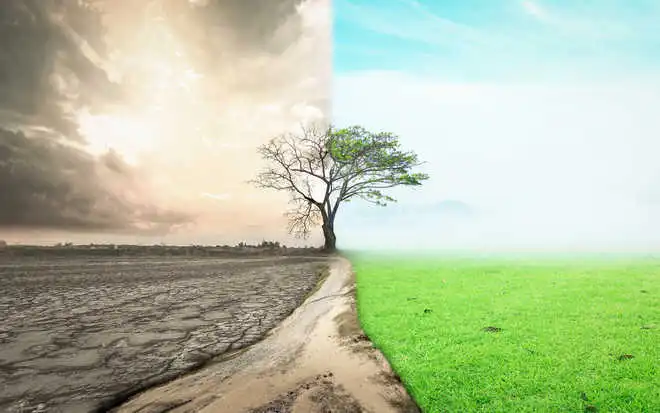What’s in today’s article?
- Why in News?
- Evolution of India’s Climate Policy
- Key Determinants of India’s Climate Policy
- The Essentials of India’s Climate Policy
Why in News?
India is faced with the challenges of sustaining rapid economic growth while dealing with the global threat of climate change. In this context, the article tries to analyse the evolution and essentials of India’s Climate Policy.
Evolution of India’s Climate Policy:
- Over-exploitation by the developed world:
- Climate change has been brought to a crisis stage by the excessive, unsustainable production and consumption patterns of the developed countries.
- Only 16% of the world’s population lives in high-income nations (like the US, EU), however they account for 74% of the excess resource use (between 1970-2017) that exceeds fair share.
- China has also overshot its sustainability limit by 15% of resource overuse.
- Therefore, the high-income countries must reduce resource use by ~70% from existing levels to reach the sustainability range.
- Resource use by the developing world: Over the same period, 58 countries representing 3.6 billion people – including India, Indonesia, Pakistan, Nigeria, and Bangladesh – stayed within their sustainability limits.
- Evolution of India’s Climate Policy:
- India and the world saw significant change in the 1990s, which prompted the creation of new regulations in a number of fields, including the environment.
- The Rio Summit of 1992 saw the emergence of the United Nations Framework Convention on Climate Change (UNFCCC) and the Convention on Biological Diversity (CBD) and Forest Principles.
- The divisions of biodiversity and climate change in India’s former Ministry of Environment and Forests gradually emerged following Rio.
- Since then, India’s climate policy has always been clear, consistent, and coordinated.
Key Determinants of India’s Climate Policy:
- Disturbance in the seasonal cycle:
- India’s civilization and economy have developed in harmony with the seasonal cycle.
- In recent decades, climate change has disrupted this harmony by blurring the distinction between seasons, which has led to increased unpredictability and negative consequences for nature and society.
- Limited land resources:
- In India, the human to land ratio is very low at 0.0021 sq km, and is continuing to recede.
- Therefore, we must learn to survive with this serious limitation, which requires understanding and an integrated management of land and water.
- Extreme weather events:
- The Germanwatch’s Global Climate Risk Index 2020 puts India as the fifth most affected country in terms of experiencing extreme weather events, a sharp rise from its 14th position in 2017.
- By 2050, rising temperatures and shifting patterns of monsoon rainfall might cost India 2.8% of its GDP and lower living conditions of about half of the nation’s population. (WB)
- India’s resolution:
- The logo of the Ministry of Environment, Forest and Climate Change (MoEFCC) – Nature Protects if She is Protected – shows India’s reverence, respect for nature, and its focus towards conserving it.
- Despite having historical cumulative emissions of less than 4% (1850-2019) and 1.9 tonnes CO2 per capita emissions, India has not dissuaded itself from taking resolute domestic and international actions that benefit the planet.
The Essentials of India’s Climate Policy:
- Vision of India’s climate policy:
- Inclusive growth for all-round economic and social development,
- Eradication of poverty,
- Declining carbon budget,
- Firm adherence to the foundational principles of the UNFCCC, and
- Climate-friendly lifestyles.
- Some of the Initiatives at the domestic level:
- The National Action Plan on Climate Change (NAPCC) 2008:
- Its eight missions have laid the ground for understanding climate change and acting on it.
- 34 Indian states and Union Territories have prepared State Action Plans on Climate Change (SAPCCs) consistent with the objectives of NAPCC.
- Adding two more Cs to its climate policy: This addition (confidence and convenient action) signifies the relevance of the slogan of ‘Sabka Saath, Sabka Vikas, Sabka Vishwas, Sabka Prayaas’. For example,
- The Leadership Group for Industry Transition (an initiative of India and Sweden) and
- The ‘Lifestyle for Environment’ movement shows that convenient actions are the only way possible.
- Net zero:
- India demonstrates its support for the multilateral approach to attain net zero emissions by 2070 in its long-term low emissions development strategy submitted to the UNFCCC.
- India has been successfully decoupling its economic growth from greenhouse gas (GHG) emissions.
- This has resulted in a reduction of the emission intensity of its GDP by 33% between 2005 and 2019.
- This is despite having no binding mitigation obligations under the UNFCCC in the pre-2020 period.
- Renewable energy
- India’s solar energy capacity has increased by more than 26 times, and wind energy capacity has more than doubled in the last 10 years.
- It now has the 5th largest installed capacity of wind, and 5th largest solar in the world, achieving a target of 40% installed electric capacity from non-fossil fuels in November 2021 (9 years ahead of schedule).
- Initiatives at the global level:
- The CBDR-RC (Common but Differentiated Responsibilities and Respective Capabilities) principle was developed largely through Indian interventions at the Rio Summit, 1992.
- Building global institutions: Such as the International Solar Alliance (ISA), the Coalition for Disaster Resilient Infrastructure (CDRI) and the Global Biofuels Alliance (GBA).
Q.1. What is the Leadership Group for Industry Transition (LeadIT)?
India and Sweden had co-launched LeadIT at the UN Climate Action Summit in New York in 2019 for inclusive and just industry transition, co-development and transfer of low-carbon technology, etc.
Q.2. What is the Global Biofuels Alliance (GBA)?
GBA is a multi-stake holder alliance of Governments, International Organizations and Industries, an initiative by India as the G20 Chair, bringing together the biggest consumers and producers of biofuels to drive development and deployment of biofuels.
Source: An Expert Explains: The evolution and essentials of India’s climate policy
Last updated on November, 2025
→ Check out the latest UPSC Syllabus 2026 here.
→ Join Vajiram & Ravi’s Interview Guidance Programme for expert help to crack your final UPSC stage.
→ UPSC Mains Result 2025 is now out.
→ UPSC Notification 2026 is scheduled to be released on January 14, 2026.
→ UPSC Calendar 2026 is released on 15th May, 2025.
→ The UPSC Vacancy 2025 were released 1129, out of which 979 were for UPSC CSE and remaining 150 are for UPSC IFoS.
→ UPSC Prelims 2026 will be conducted on 24th May, 2026 & UPSC Mains 2026 will be conducted on 21st August 2026.
→ The UPSC Selection Process is of 3 stages-Prelims, Mains and Interview.
→ UPSC Result 2024 is released with latest UPSC Marksheet 2024. Check Now!
→ UPSC Prelims Result 2025 is out now for the CSE held on 25 May 2025.
→ UPSC Toppers List 2024 is released now. Shakti Dubey is UPSC AIR 1 2024 Topper.
→ UPSC Prelims Question Paper 2025 and Unofficial Prelims Answer Key 2025 are available now.
→ UPSC Mains Question Paper 2025 is out for Essay, GS 1, 2, 3 & GS 4.
→ UPSC Mains Indian Language Question Paper 2025 is now out.
→ UPSC Mains Optional Question Paper 2025 is now out.
→ Also check Best IAS Coaching in Delhi

















